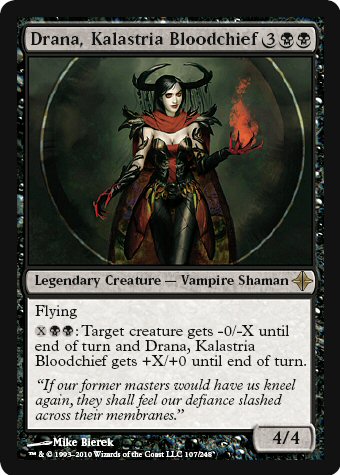The Operative: “Have you looked at this scan carefully, Doctor? At his face? It’s love, in point of fact. Something a good deal more dangerous.”
I had a rather unforgettable PTQ season with Thopter Depths, managing a winning record, but not much better. I thought that the deck would be exactly what I liked, but it turns out I was wrong.
But first, since we all know everyone just came for the preview, let’s do that.

Okay, let’s take a look at our new vampire queen. First off, she’s a five-drop, putting her in legitimate casting range for Vampire decks. She’ll compete with Ob Nixilis for that five-slot. She does fit the curve decently enough, coming down after Nocturnus.
4/4 with Flying, certainly not too shabby. It’s not Baneslayer combat stats, but as we’ll see, she can certainly tangle with a Baneslayer Angel if need be, but she’ll need 7 mana open.
Her best use, though, is in her ability. For XBB, she drains creatures (-0/-X) and then uses that to pump herself (+X/+0), which is certainly very thematic. It has a very Vampire -esque feeling to it, for sure. Definite flavor points, and also quite cool from a mechanical point of view.
Drana also gives a nice use for some late game mana flood, as well as giving you a reusable removal spell. Keep in mind that you can also drain for more than the creature’s toughness, if necessary. You can drain a 1/1 Saproling Token for as much as you like, especially helpful in Alpha Strike situations where you may want to pump Drana a lot. However, if the target creature is removed before the ability resolves, Drana does not get pumped, but instead the ability is countered on resolution due to no legal targets.
So, where do I see Drana ending up? She’s a good option for Standard Vampire decks and other Mono- Black decks that may want some late game presence after they sputter out. In Limited, she’s a legitimate bomb, who will no doubt push players into mono- or heavy Black decks to use her. Removal is good, and a reusable removal spell in Limited will be extremely good.
Moving on, let’s return to deck selection. Gavin Verhey wrote a somewhat maligned article on players having “The Aura.” While I don’t believe in “the Aura,” I do believe in the science of the brain. Research suggests that your brain waves may differ depending on a variety of factors, and that certain brain waves can cause higher performance. It has been seen in Tibetan monks during transcendental meditation, and many scientists postulate that it occurs in any highly performing individual, whether Chess Grand Master or Superstar Athlete (Michael Jordan is often thought to be in this state when he was in “The Zone”).
So, what factors can go in to performance? First, obviously, comes lots and lots of practice. Just because your brain is in a higher cognitive state doesn’t mean you can suddenly tee off with Tiger. You will need to have the requisite skills to take your performance to a higher level. This is why so many of the greatest players have amazing testing regimens. The more you play Magic, the better you will get.
However, I think another major factor is the selection of your deck.
As I mentioned earlier, I had a rather forgettable PTQ season with DDT. I actually really like the Thopter/ Sword combo, but the Dark Depths combo, which I thought I would like, was too warping for me to properly utilize.
I’m not saying the deck is bad, as obviously it’s quite good. I’m saying it’s bad for me and my style of play. When playing the deck, I became overly focused on assembling the Marit Lage token that I let it affect the way I played the game. In doing so, I played poorly with the deck, even though I had hundreds of test games with it, and over two dozen tournament matches before the final PTQ. In the end, I was never able to get comfortable enough with the deck to focus on the rest of the game. I was always focusing on my own deck, and missing vital other parts of the game.
If I had it to do over again, I would play Zoo, a deck I have had reasonable success with over the last two years, and with which I am innately comfortable. When playing Zoo, I am familiar and comfortable enough with the deck that I can focus my active attention on my opponents plan and strategy. This allows me to play tighter, with fewer mistakes.
Getting comfortable with your deck is very important, and should be one of the factors when you decide which deck to play.
Another factor is understanding the overall strategy of the deck, and how the pieces work together. Despite my many games of practice with DDT, there were times when I didn’t understand or couldn’t pick out the right line of play. If I had Dark Depths, Sword of the Meek, and Muddle the Mixture in hand, I couldn’t automatically figure out what I should be transmuting for. I know it depends on your opponent and their deck, but even then, I had trouble, and I should have recognized that earlier. With Zoo, I could often figure out which cards I wanted to use, and where to properly use them. I didn’t feel lost with the deck.
Playing Magic correctly is more than just casting spells and not missing triggers. You have to actually be advancing your strategy, moving toward the point in the game where your opponent scoops up their cards. You might play technically precise Magic, but that is not the same as playing good Magic. You can play each turn without making actual errors, without making a mistake, but if you don’t understand and advance your strategy, you will lose.
Finally, having an intimate knowledge of your deck makes it easier to determine which outs you are drawing to in bad situations. I build my Zoo decks with extreme care, and I intimately know the decklist. With DDT, I always struggled to remember the exact 60 cards, even though I filled out the deck reg. To quote Tom LaPille:
If you think you are intellectually comfortable with a deck that you might play but you have a deep-seated unease about it, I suggest staying away.
I wish I had read this line 3 months ago, as although I understand each part of the DDT deck on an intellectual level, I never felt comfortable with it. To extrapolate, I know how the deck functions, from a mechanical standpoint. I know all the triggers and the way the abilities stack and so on and so forth. I even won a few matches by having opponents who didn’t.
But I never really saw the whole deck as more than the sum of its parts. It is an elegant deck, well designed, but I only ever played with 60 cards, not one deck. To use an analogy, I saw the engine, and the transmission, and the transfer case, but I never saw the actual car. I didn’t ever have it come together.
Capt. Malcolm Reynolds: “Love. You can know all the math in the ‘Verse, but take a boat in the air you don’t love, she’ll shake you off just as sure as the turning of worlds. Love keeps her in the air when she oughta fall down, tells ya she’s hurtin’ ‘fore she keens. Makes her home.”
Now, that’s not to assume I only like to play aggro decks. My favorite deck of all time is still the Five-Color Control decks of last year, which I used to great effect and intuitively got. I knew when to Cryptic, when to flash in Plumeveil, and so on and so forth. I feel the same way with my modified Boss Naya deck right now. I’ve removed the Ranger of Eos from the deck, because I never enjoyed using it. Mostly, I didn’t like fetching a Scute Mob and a Nacatl, and I found myself boarding them out every time. Is that right for you? Maybe not. But my win percentage has increased since then, so it’s probably right for me.
I’ll eventually add them back in when I become more comfortable with them, as I’m testing out new ideas and new strategies with them. I can see the inherent power; I understand them on an intellectual level. But if they’re not being played properly, then they are a hindrance. To restate, if I cannot get into a natural groove of comfort, “the Zone,” if you will, while playing them, then they may be actively hindering my plans. Practice, my friends, will eventually lead me to better utilize them.
I want to talk about one last thing before I leave this week, and that’s Gavin’s latest article on how to broach the topic of Magic. Gavin tries a number of methods, many of which seem perfectly acceptable. I only want to ad my 2 cents with this:
Never be ashamed of what you like. Others may not like it, and that’s fine, but if you are ashamed of what you do, others will see that. I read an editorial a long time ago from Jolly Blackburn, the editor of KODT Magazine, in which he talked a little bit about being a Nerd, and how that affects his life. In it, he provided the best definition of what it is to be a nerd that I’ve ever heard, and that I continue to use to this day: (paraphrased) “A Nerd is someone who likes whatever he wants to like, and isn’t ashamed of it.”
I like playing strategy card games. I have played competitive Pinochle, Spades, and Poker. However, I also like Dragons and Ninjas. My license plate is CTHULHU, and I have the Magic: the Gathering logo on my back window, 2 feet wide. I wear my Magic: the Gathering Visor as much as I wear my Indianapolis Colts hat. I don’t try to hide what I like or what I do, and if I never go to another tournament again, I’d still proudly play in my basement with my friends.
So, while Gavin explains his game in terms of what he has been able to win, and where he has been able to go, which is what works for him, and is perfectly fine, don’t be afraid to openly love the game that has given so much happiness to you as a player, judge, or whatever your interaction with the game.
Until next time, this is Jeff Phillips, reminding you: Don’t make the Loser Choice.

